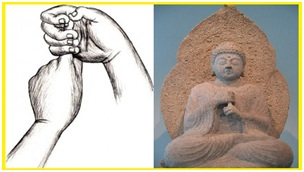Buddha Purnima 2022: Know Buddhist Mudras, Hand signing and their Meaning
Buddha Purnima 2022: This year, it was celebrated on May 16. The symbolic gestures (Mudras) through the iconography of Buddha image to evoke particular ideas during Buddhist meditation or rituals. On Buddha Purnima, let us have a look at Buddhist Mudras, hand signing , and their meaning.
What is Mudra?
It is a position of hand often represent in Buddhist art and used in practice to allocate a particular state of mind. Commonly found mudras or pediatrician of Buddha are hands folded in the lap which signifies meditation, a palm held up facing outward signifies the act of teaching or reassurance or an open palm pointed downward signifies generosity.
Buddhist Mudras, Hand Gestures and their Meaning
1. Dharmachakra Mudra
It is also called as the singing of 'Teaching of the Wheel of Dharma' that report one of the most important moments in the Buddha's life as he performed the Dharmachakra mudra in his first sermon in Sarnath after he attained enlightenment. It is performed with the help of both the hands which are held against the chest, the left-facing inward, covering the right facing outward.
2. Dhyan Mudra
It is also known as Samadhi or Yoga mudra. It is performed with the help of two hands which are placed on the lap and place the right hand on the left hand with stretched fingers (thumbs facing upwards and other fingers of both the hand resting on each other.) This is the characteristic gesture of Buddha Shakyamuni, Dhyani Buddha Amitabh and the Medicine Buddha.
3. Bhumisparsa Mudra
This singing is also known as “touching the Earth” which represents the moment of the Buddha's awakening as he claims the earth as the witness of his enlightenment. It is performed with the help of the right hand, which is held above the right knee, reaching toward the ground with the palm inward while touching the lotus throne.
4. Varada Mudra
This mudra represents the offering, welcome, charity, giving, compassion and sincerity. It is performed with the help of both the hands in which palm of the right hand facing forward and fingers extended and left-hand palm placed near omphalos with extended fingers.
5. Karana Mudra
This gesture signifies the warding off evil which is performed by raising the index and the little finger and folding the other fingers. It helps in reducing sickness or negative thoughts.
6. Vajra Mudra
This gesture denotes the fiery thunderbolt that symbolizes the five elements, i.e. air, water, fire, earth, and metal. It is performed with the help of right fist, left-hand forefinger, which placed by enclosing the erect forefinger of the left hand in the right fist with the tip of the right forefinger touching (or curled around) the tip of the left forefinger.
7. Vitarka Mudra
It signifies the discussion and transmission of the teachings of the Buddha. It is performed by joining the tips of the thumb and the index fingers together while keeping the other fingers straight, which is just like to Abhaya Mudra and varada mudra but in this Mudra the thumbs touching the index fingers.









No comments:
Post a Comment